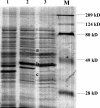Isolation and detection of Campylobacter concisus from saliva of healthy individuals and patients with inflammatory bowel disease
- PMID: 20519479
- PMCID: PMC2916630
- DOI: 10.1128/JCM.02391-09
Isolation and detection of Campylobacter concisus from saliva of healthy individuals and patients with inflammatory bowel disease
Abstract
The presence of Campylobacter concisus in the saliva of healthy individuals and patients with inflammatory bowel disease (IBD) was examined. C. concisus was detected in 97% of the healthy individuals and 100% of the patients with IBD tested. The C. concisus culture positivity rate in younger children was significantly lower than that in the other age groups.
Figures


References
-
- Engberg, J., D. D. Bang, R. Aabenhus, F. M. Aarestrup, V. Fussing, and P. Gerner-Smidt. 2005. Campylobacter concisus: an evaluation of certain phenotypic and genotypic characteristics. Clin. Microbiol. Infect. 11:288-295. - PubMed
-
- Laemmli, U. 1970. Cleavage of structural proteins during the assembly of the head of bacteriophage T4. Nature 227:680-685. - PubMed
-
- Lane, D. J. 1991. 16S/23S rRNA sequencing, p. 115-175. In E. Stackebrandt and M. Goodfellow (ed.), Nucleic acid techniques in bacterial systematics. John Wiley & Sons, Ltd., Chichester, United Kingdom.
Publication types
MeSH terms
Substances
Associated data
- Actions
- Actions
- Actions
- Actions
- Actions
- Actions
- Actions
- Actions
- Actions
- Actions
- Actions
- Actions
- Actions
- Actions
- Actions
- Actions
- Actions
- Actions
- Actions
- Actions
- Actions
- Actions
- Actions
- Actions
- Actions
- Actions
- Actions
- Actions
- Actions
- Actions
- Actions
- Actions
- Actions
- Actions
- Actions
- Actions
- Actions
- Actions
- Actions
- Actions
- Actions
- Actions
- Actions
- Actions
- Actions
- Actions
- Actions
- Actions
- Actions
- Actions
- Actions
- Actions
- Actions
- Actions
- Actions
- Actions
- Actions
- Actions
- Actions
- Actions
- Actions
LinkOut - more resources
Full Text Sources
Other Literature Sources
Medical
Molecular Biology Databases

